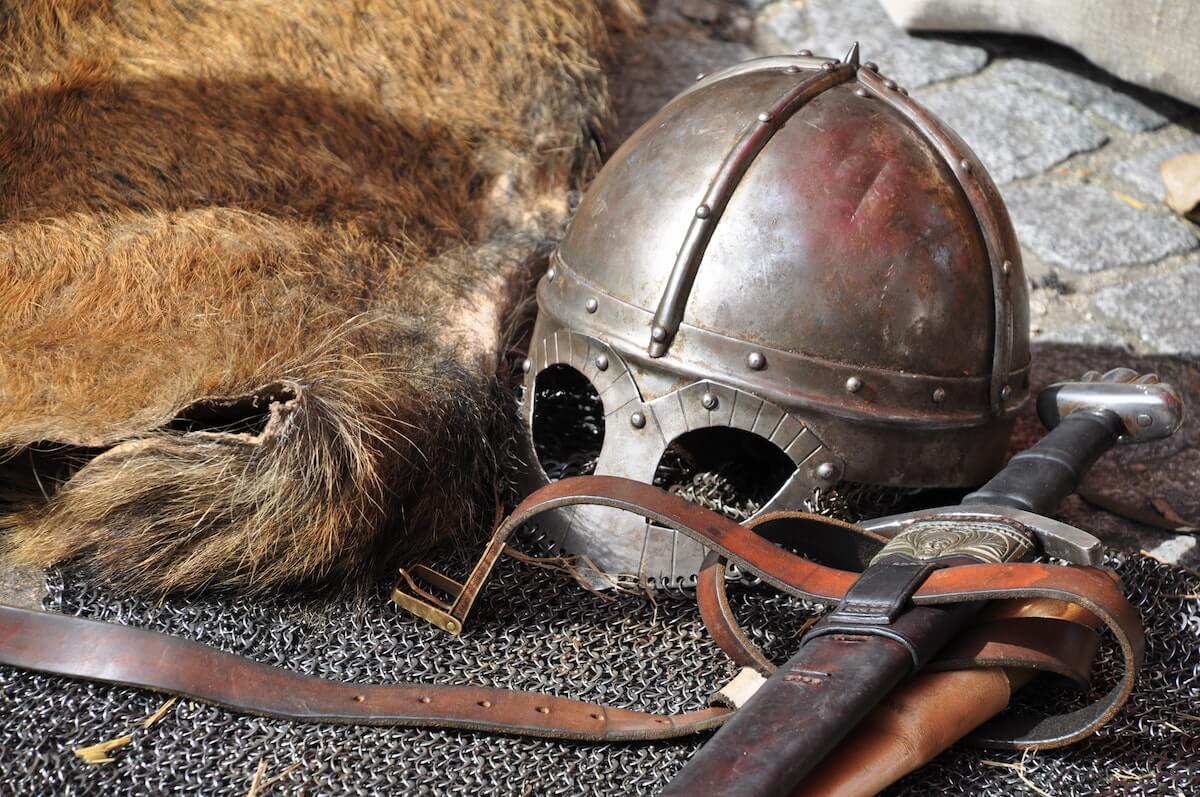Not a zombie-related media out there fails, in some way, to tip its hat to George A. Romero.
The “Father of the Zombie Film” directed the original Night of the Living Dead (1968) and follow-ups Dawn of the Dead (1978) and Day of the Dead (1985), amongst a career of other horror films.
But Romero wanted to prove he could break out of these horrific confines and tell a different story.
His answer? Knightriders.
No, not the 80s TV show Knight Rider, complete with prime David Hasselhoff and a talking computer car.
Like #vanlife but with a hardcore 1980s slant, Romero’s story follows a band of outsiders who run a traveling renaissance fair almost like an independent pro wrestling organization.
Don’t worry – it gets a little weirder.
Following the Arthurian code, the knights compete for the crowd by jousting or battling hand-to-hand. But instead of horses, motorcycles are their trusty steeds.
Written, directed, and edited by Romero, this dramatic fantasy effort is said to be semi-autobiographical.
With all this creative control, let’s examine how Romero’s zombie genre jailbreak shaped up.
So is Knightriders a good movie?
The Plot of Knightriders
After visions of a blackbird, King Billy (Ed Harris) and Queen Linet (Amy Ingersoll) wake and join the rest of their traveling troupe.
The day’s program proceeds with a jousting competition for a lively and attentive audience who revels in the feats of the performers.
But after the performance, the tensions rippling through the group bubble over. Local law enforcement Sheriff Rilly (Bingo O’Malley ) shakes down the company for money. Sir Morgan (Tom Savini) threatens a coup d’etat, believing he should be king. And Billy struggles to recover from yet another injury.
With the group fraying, a promoter, Bontempi (Martin Ferrero), approaches Sir Morgan and anyone willing to leave for a lucrative deal.
With the company split, a final battle looms between Billy and Sir Morgan’s supporters.
Who will come out on top?
The Rest of the Main Cast Includes:
- John Amplas as “Whiteface”
- Gary Lahti as Sir Alan
- Patricia Tallman as Julie Dean
- Brother Blue as Merlin, The Wizard
- Ken Foree as John “Little John”
- Scott Reiniger as Sir Marhalt
- John Hostetter as Friar Tuck
- Warner Shook as Pippin
- Randy Kovitz as “Punch”
- Cynthia Adler as Rocky
- Harold Wayne Jones as Sir Bors
- Michael P. Moran as Deputy Cook
- Albert Amerson as The Indian
- Christine Forrest as Angie, Morgan’s Girlfriend
- Donald Rubinstein as The Lead Minstrel
- Stephen King as “Hoagie Man”
- Greg Besnak as “Rhino”, Bald Mustachioed Head Biker
- Gary Davis as Biker, Rhino’s Sidekick
Fun Fact: Authors Stephen and Tabitha King make cameos in the film.
The Good Things
Ed Harris as King Billy, +3 Points
We are kept from the details of King Billy’s origins, but his motivation is clear.
He believes in his principles, like not shaving his mounds of nappy chest hair.
He refuses to take a day off, despite needing stitches to close a ghastly wound between his neck and shoulder.
Hellbent on staying an outsider, he keeps the troupe clear of promotional opportunities and living by a mock Arthurian code.
He’s so extreme he refuses to sign an autograph for a wide-eyed kid. The boy wants him to John Hancock a motorcycle magazine with Billy’s picture. Billy objects because it lumps him alongside famous stunt rider Evel Knievel.
When challenged by Queen Linet for not indulging the child fan, he yells, “I’m not trying to be a hero. I’m fighting the dragon!”
In his first starring role, Harris’s King Billy is a bit wild in the eyes when ranting yet otherwise graceful. He gives knowing nods. He watches stoically when the group performs, showing confidence and conviction.
Disaffected and determined to stay true to his code, you wonder if Billy represents Romero’s feelings of entrapment within the film industry.
He’s a fascinating character, and Harris’s tempered performance works.
Merlin, +1 Point
Merlin is the band’s licensed doctor. He tends to anyone wounded in the mock jousts or even passersby who got too close to the action.
And he adds a mystical quality to the film, quietly tending to King Billy’s injury while seemingly prophesying to him.
He’s more shamen than a physician with his black butterfly facial tattoos, golden earrings, and long coat. A mystic, he blows a harmonica and tells a resting Billy the tale of King Arthur.
The group’s spiritual guide, he forms a deep bond with Billy, a conscience character who muses philosophically and keeps him on course.
Pippin and Punch, +1 Point
The announcer of the company, Pippin, is suspected of being gay.
Yet rather than mocking or disapproving, the troupe is frustrated that he hasn’t come out openly.
Accepting a homosexual character is pretty novel for early 80s films, and the character even goes on to find love with Punch.
Credit to the film for this inclusive attitude.
Billy’s Destiny, +2 Points
Spoiler Alerts: This Section Will Ruin the Film’s Excellent Conclusion
The most entertaining part of this movie isn’t the concluding battle between Morgan and Billy’s supporters. While that seems a fitting moment to end the movie, the film finishes Billy’s character arc.
After losing his crown, Billy takes off with his new Indian companion, tying up loose ends.
He beats Sheriff Rilly as retaliation, avenging his comrade Rilly assaulted, just as he threatened to do earlier in the film.
He finds the boy who wanted his autograph, interrupting the kid’s classroom to hand over his sword to him.
Then Billy gets back on his bike and, feeling the weight of his injuries, begins hallucinating about riding a horse like an actual Medieval Knight.
He runs smack into a semi-truck and is killed.
Narratively, it’s perfect. Reminiscent of the ending to the classic Vanishing Point (double spoiler!), Billy’s only escape from society and into fantasy seemed to be death.
For the mock noble king, it’s an honorable and thought-provoking end.
The Not-As-Good Things:
Too Long, -2 Points
I love when directors get ample time to tell their stories, but Knightriders is 145 minutes long.
That’s the runtime of multi-generational family epics, not nitro-fueled renaissance fairs.
And there are some needless scenes. For example, two bikers inexplicably try to steal some of the group’s gear and are chased down. It’s not an exciting sequence that helps advance the plot or fill out the characters.
Lastly, the pacing stalls. For example, the opening sequence, in which the troupe prepares for and then performs for a rowdy crowd of short-shorted beer-swillers, lasts the first ~40 minutes.
Twenty to twenty-five minutes would have been enough to introduce the audience to the performer’s talent and set the stage for the dramatic conflict.
Too Literal, -2 Points
This film is at its best when Billy and Merlin contemplate the nature of his destiny or in the final act, where Billy completes his knight’s tasks.
Unfortunately, much of the movie focuses on the group’s in-fighting, like the world’s strangest episode of VH1’s Behind the Music.
The film had the potential to go in provocative directions. For example, had Billy been hallucinatory, his followers more like a cult who believes they are Arthurian knights in a modern setting, what a film it could have been.
Should I Watch Knightriders?
Total Arbitrary Points Score: 3 Points
If you love George A. Romero and are curious about this non-horror passion project, watch Knightriders to complete your Romero films punch card.
And if you’re a fan of cult or oddball movies, there might be something in this one for you as well.
Otherwise, I don’t recommend this film.
I can’t put it in those so good it’s underappreciated, so bad it’s revered, or so off-the-wall it’s thought-provoking categories.
The stunt work must have been difficult and dangerous, but it won’t awe you. Jousting by motorbike is more novel than exhilarating.
The final act gets delightfully interpretive, but we needed more.
Credit to Romero for branching out creatively, but I couldn’t quite get into this journey.
Enjoyed this Post?
Thank you so much. If you’d like to get a ping when I have a new article, you can join my newsletter below.
Disclaimer:
This review’s factual information was gathered through online sources, like Wikipedia, IMDB, or interviews. Misrepresentations and errors are possible but unintentional.
Making art is hard. This is a fan’s blog. Any criticisms are meant to be constructive.




